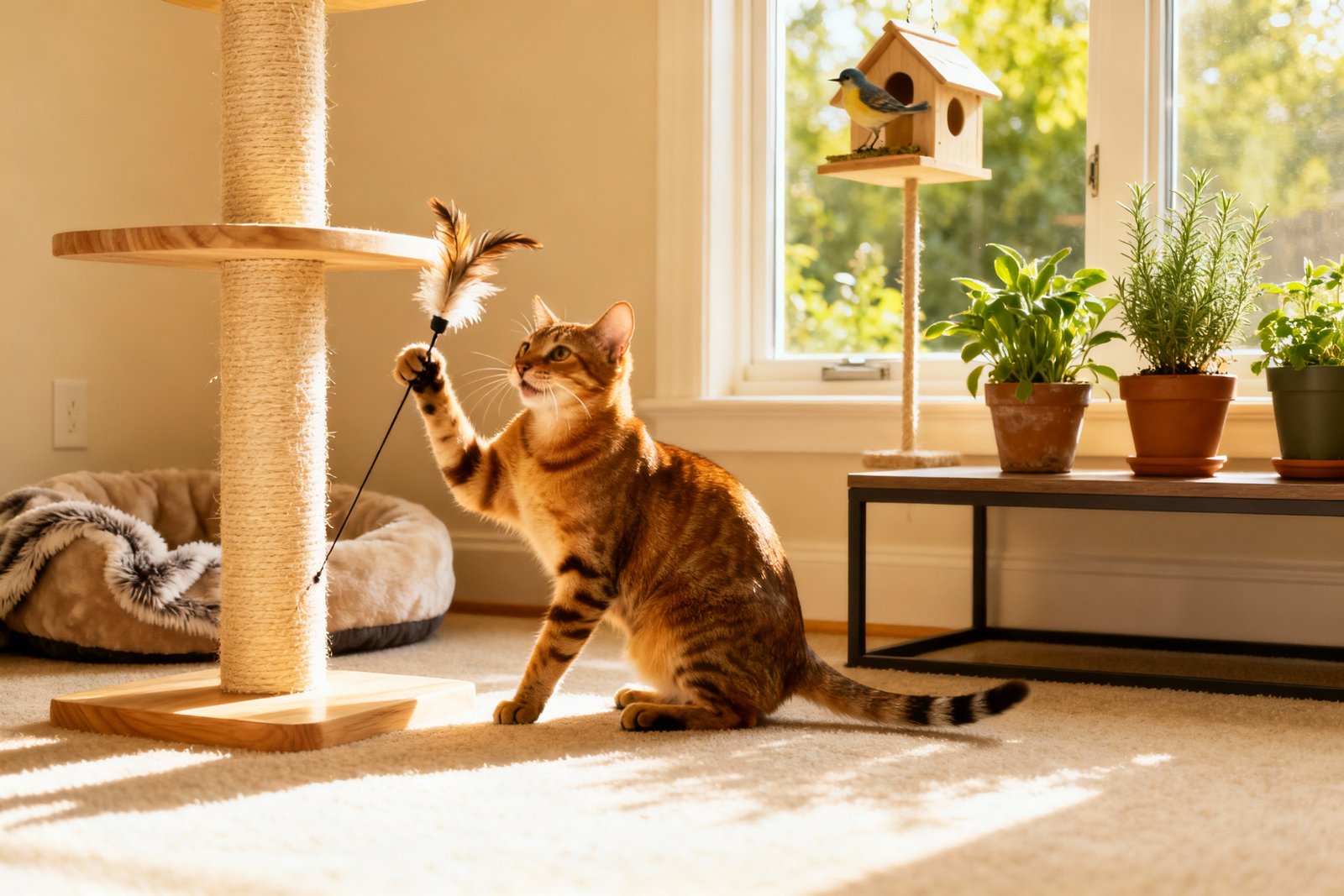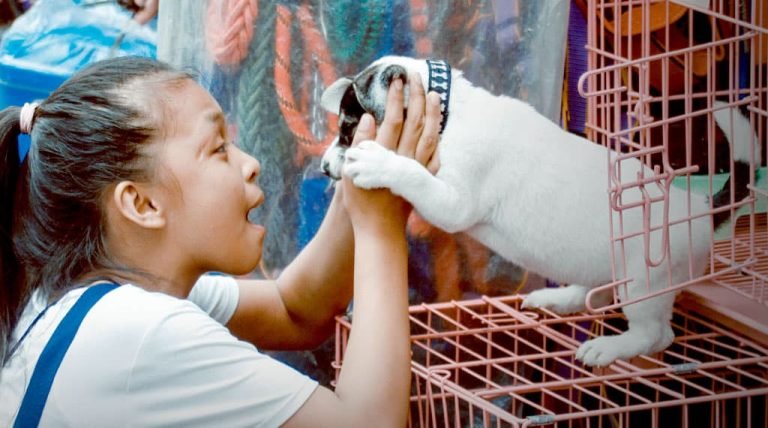“how To Keep Your Cat Healthy Indoors (without Driving Them Crazy)”
You want a healthy indoor cat who isn’t plotting your downfall from behind the curtains? Totally doable. Indoor life keeps cats safe, but it also risks boredom and extra fluff on the waistline.
The trick is building a mini cat universe that feeds their hunter brain and keeps their body in top shape. Let’s turn your home into a feline-friendly paradise—without turning your brain to mush in the process.
Rethink “Indoor” as an Adventure Zone
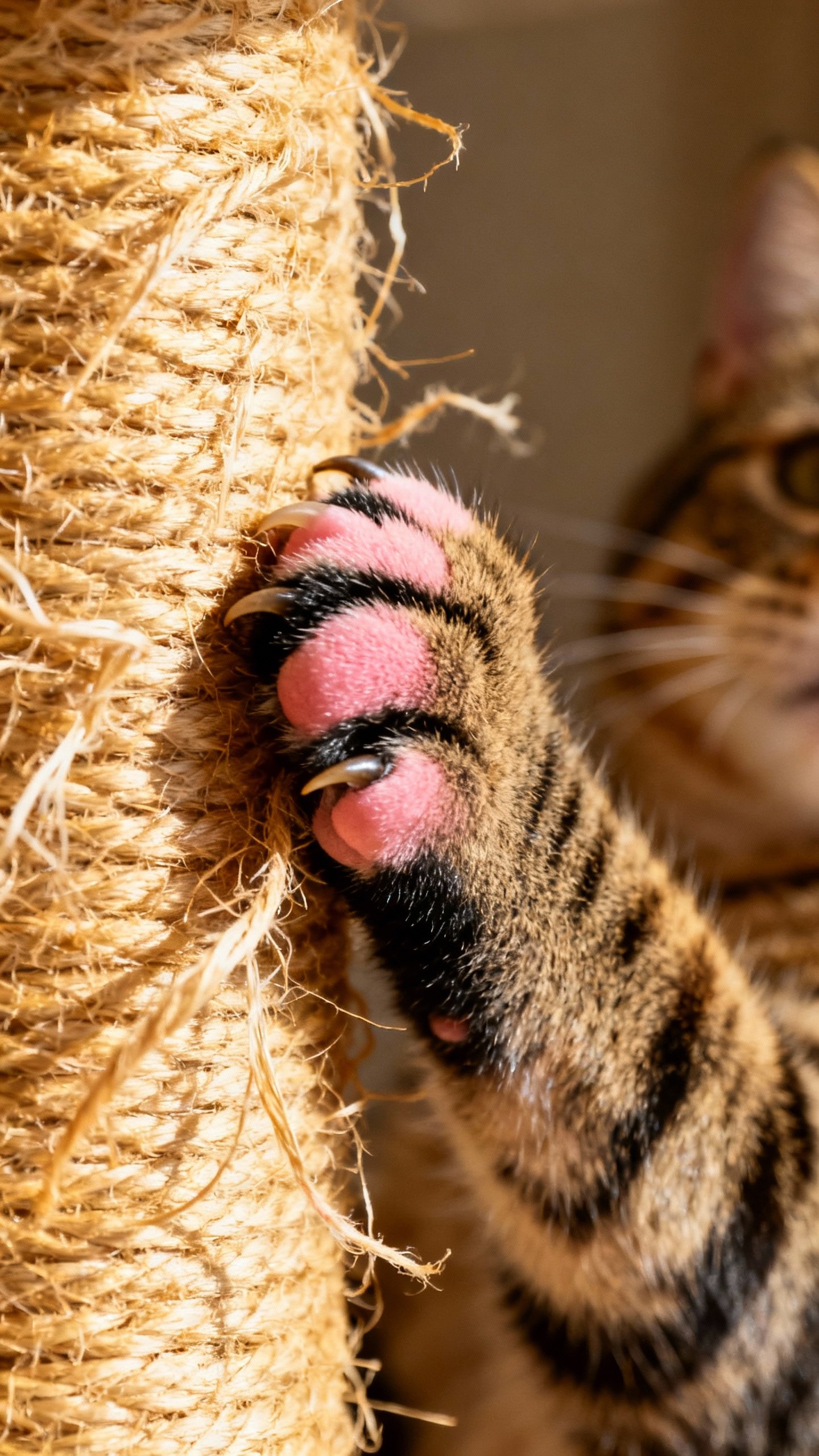
Cats need territory, vantage points, and things to “own.” Indoors just means you craft that terrain inside.
- Vertical space = confidence. Add cat trees, shelves, or windowsill perches. High spots reduce stress and boost exercise.
- Multiple “safe zones.” Create quiet hideaways in different rooms—think cozy beds, boxes, or a blanket fort.
- Windows are TV for cats. A bird feeder outside a window can turn boredom into daily entertainment.
DIY Vertical Playground
You don’t need custom carpentry.
Stack sturdy bookshelves, use adhesive wall steps, or mount a couple floating shelves. Keep pathways connected so your cat can cruise around like a furry Spider-Man.
Feed the Hunter, Not Just the Bowl
Cats evolved to hunt small meals all day. One big bowl?
Snoozefest, followed by belly spread.
- Use puzzle feeders. Start easy, then level up. This slows eating and adds brainwork.
- Small, frequent meals. 3–5 mini-meals mimic natural hunting. Auto-feeders help if you value sleep.
- Rotate proteins and textures. Within your vet-approved diet, mix wet and dry.Wet food supports hydration and satiety.
Snack Hunts FTW
Hide a few treat kibbles in different rooms once a day. Announce “hunt time,” then watch the tiny panther vibes activate. FYI: this also reduces 3 a.m. zoomies.
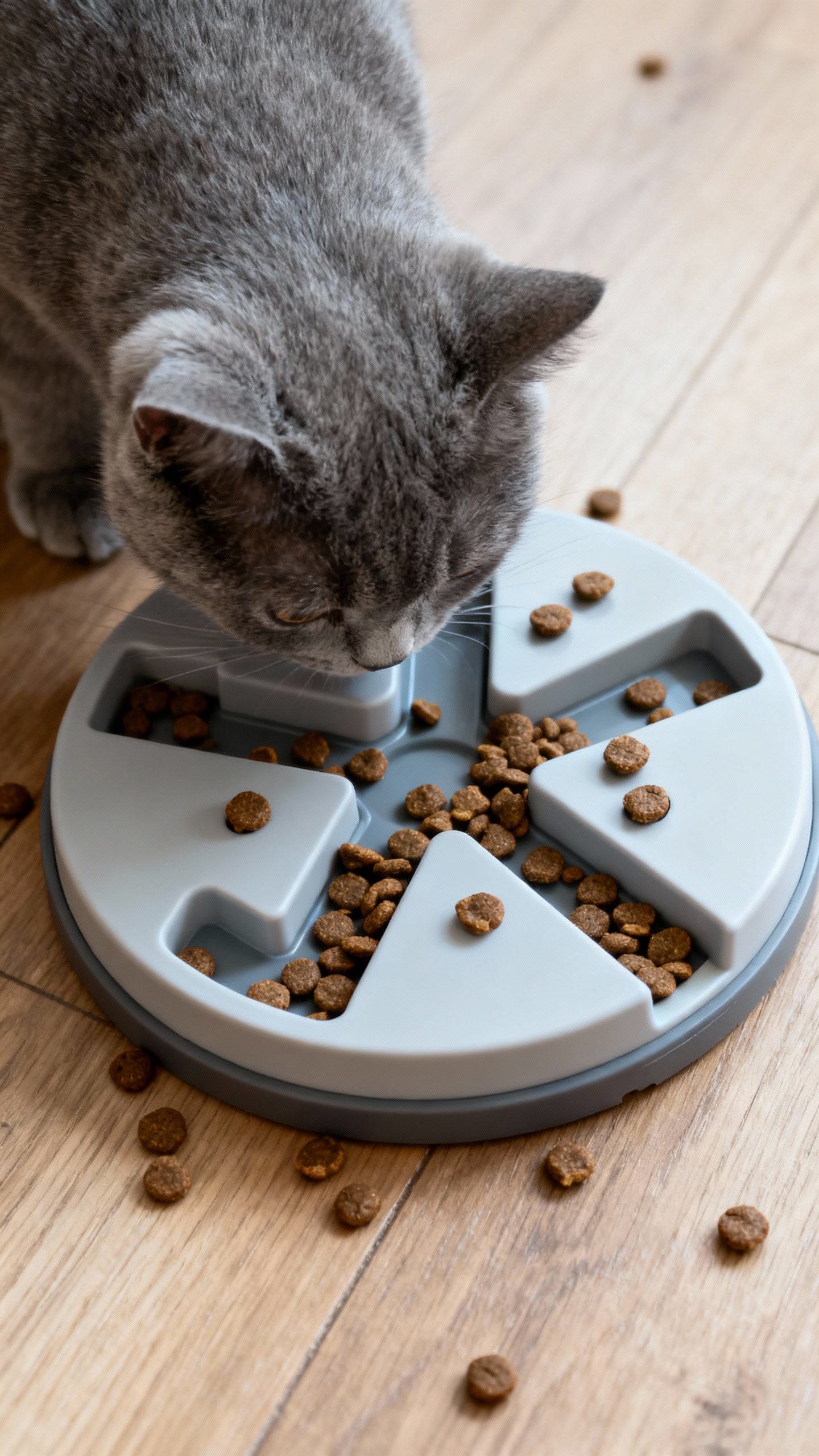
Play Like a Predator, Not a Clown
Cats don’t want random flailing; they want prey behavior.
Think slinky, darting movements—not helicopter toy chaos.
- Use wand toys correctly. Make the “prey” hide, peek, dart, and freeze. Let your cat catch it at the end for satisfaction.
- Two 10-minute sessions daily. Short and consistent beats chaotic marathons.
- Rotate toys weekly. Put half away. Reintroduce them like new episodes instead of a toy graveyard.
Laser Pointer, But Ethically
Finish laser play with a real toy or treat they can “capture.” Otherwise, you create frustration.
No one likes a boss fight with no loot drop.
Litter Boxes: Quiet, Clean, and Plentiful
If you want perfect litter habits, set cats up to win. Bad setups cause stress and accidents—then everyone’s upset.
- Follow the rule: number of cats + 1 boxes. Even with one cat, two boxes = fewer “mistakes.”
- Location matters. Place boxes in low-traffic, quiet areas—away from loud machines and food.
- Size and type. Large, open boxes work best. Many cats hate covered boxes.
- Clean daily. Scoop once or twice a day.Replace all litter regularly.
Subtle Signs of Litter Trouble
If your cat lingers, cries, strains, or makes frequent tiny pees, call your vet—like, now. Urinary issues escalate fast, especially in males.
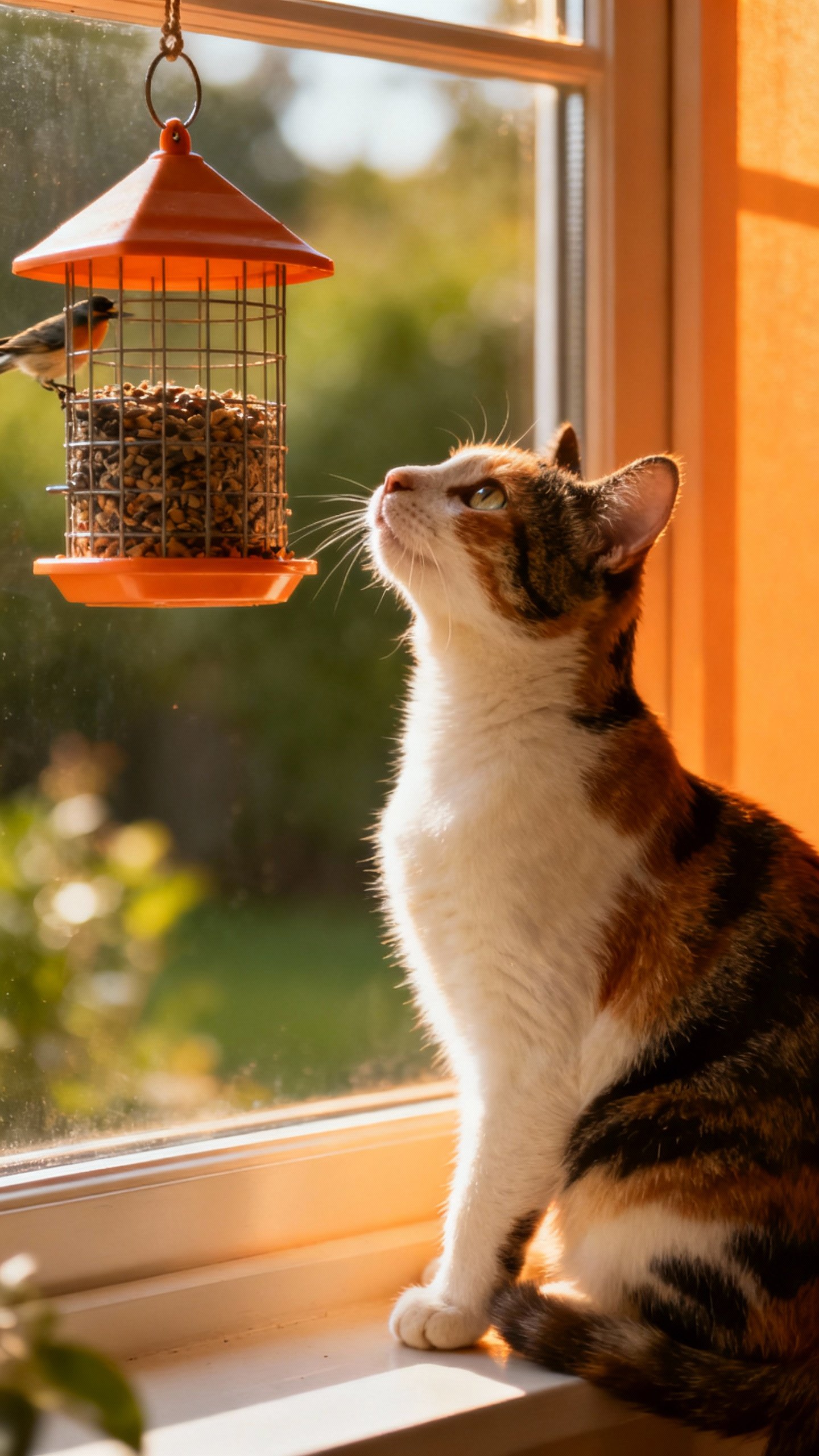
Scratch, Climb, Nap: The Holy Trinity
Cats scratch to mark territory, shed nail husks, and stretch. If you don’t provide options, your couch volunteers.
- Offer different textures. Sisal, cardboard, and carpet.Vertical and horizontal options.
- Place posts strategically. Near favorite naps and entrances—where cats instinctively mark.
- Encourage the habit. Sprinkle catnip or use a pheromone spray. Reward every scratch session.
Nap Zones That Actually Work
Warmth and safety sell. Beds near sun patches, shelves with soft blankets, or an elevated cubby will beat your laundry pile.
Sometimes.
Health Basics You Can’t Ignore
I know, the unsexy stuff. But it keeps your cat healthy long-term. IMO, prevention equals fewer expensive emergencies.
- Annual vet exams (twice for seniors 10+). Indoor cats still need vaccines, dental checks, and weight monitoring.
- Spay/neuter. Reduces roaming behaviors, spraying, and certain cancers.
- Weight management. Use a digital scale monthly.Aim for a visible waist and easy feel of ribs under a thin fat layer.
- Dental care. Try dental treats or rinses. Brush if your cat tolerates it—start super slowly.
- Parasite prevention. Fleas and worms still happen indoors (yes, really). Follow your vet’s plan year-round.
Hydration Hacks
Cats are desert creatures; they sip like they’re paying per drop.
Use a fountain, place multiple bowls, and feed more wet food. Add a splash of water or broth (no onions/garlic) to meals for stealth hydration.
Enrichment That Doesn’t Drive You Nuts
You want a happy cat and a life. Balance is key.
- Window setups. Bird feeder + perch = hours of cat Netflix.
- Cat-safe plants. Cat grass and catnip planters offer legal enrichment.Avoid lilies, philodendrons, and pothos.
- Training sessions. Teach sit, high-five, or “come.” Use clicker training. It’s quick and surprisingly fun.
- Calming aids. Pheromone diffusers help sensitive cats, especially during changes.
For Multi-Cat Homes
Use the “resources everywhere” strategy:
- Multiple feeding stations
- More than one litter area
- Duplicate favorite beds and posts
Reduce competition and you reduce drama. Your cats will still throw shade, but less WWE.
Safe Outdoor Flavors (Without the Risk)
Let your cat taste the outdoors safely.
You’ll protect wildlife and your vet bills.
- Leash training. Start with a snug H-harness indoors. Reward tiny steps. Keep sessions short and positive.
- Catios or window boxes. Even a small mesh-enclosed balcony wins big.
- Stroller walks. Sounds extra, works great for shy or senior cats.
Seasonal Check-ins
Heat waves?
Add cooling mats and extra water. Winter? More cozy beds near windows and a little extra play to offset lazier days.
Adjust routines with the weather like a pro.
FAQ
How much should I play with my indoor cat?
Aim for two 10–15 minute sessions daily. Make it interactive with wand toys and end with a “catch.” If your cat is high-energy, add a quick evening snack hunt to drain the zoomies.
What’s the best diet for indoor cats?
Focus on portion-controlled, high-quality food that fits their life stage and health needs. Include wet food for hydration.
If weight is a concern, ask your vet for calories-per-day and measure with a scoop or scale. FYI: “Free-feeding” often means “free-chunking.”
My cat scratches the couch. Help?
Place a sturdy sisal post directly next to the couch arm they target.
Reward every scratch on the post, use double-sided tape on the couch temporarily, and move the post slowly to a more aesthetic spot once the habit sticks.
Do indoor cats really need vet visits and vaccines?
Yes. Indoor cats still face dental disease, obesity, and sneaky issues like kidney or thyroid problems. Core vaccines and regular exams catch problems early and save money long-term, IMO.
How do I know if my cat is bored?
Watch for overgrooming, pestering you constantly, aggression during play, or chaotic zoomies every single night.
Add structured play, puzzle feeders, and new vertical space. If behavior changes suddenly, call your vet to rule out pain.
Is a cat fountain worth it?
Usually, yes. Many cats drink more from moving water.
Clean it weekly and replace filters as directed. Pair with wet food for a hydration win-win.
Conclusion
Indoor cats thrive when their world feels rich, not restricted. Build vertical territory, feed their hunter instincts, and keep routines consistent.
Mix in smart play, solid health care, and a touch of the outdoors—minus the risk. Do that, and your cat stays healthy, happy, and only glares at you when you’re late with dinner. IMO, that’s a fair deal.

